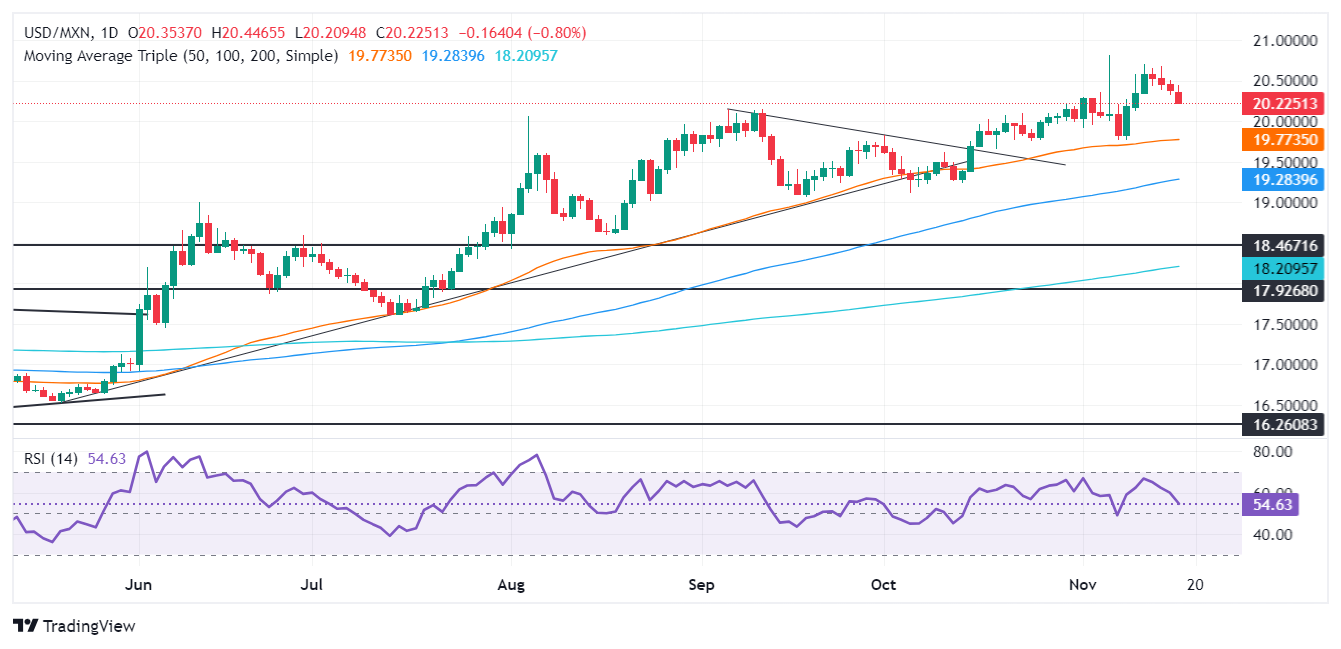- The Mexican peso continues its upward trend for the fourth consecutive day amid favorable risk sentiment.
- Banxico’s recent rate cut to 10.25% reflects ongoing inflation concerns with forecasts adjusted to 4.7% by the end of 2024.
- Moody’s adjustment of Mexico’s credit outlook to negative highlights potential fiscal and economic challenges arising from judicial reforms.
- Traders monitor the possible impact of Trump’s economic policies on the Fed’s rate decisions.
The Mexican Peso appreciated against the US Dollar at the beginning of the week, gaining 0.39% during the North American session. A light economic agenda in Mexico and the US keeps traders digesting last week’s Bank of Mexico (Banxico) rate cut and US inflation data. USD/MXN is trading at 20.27 at the moment to write.
Last Thursday, Banxico lowered rates by 25 basis points to 10.25% as expected, although the central bank acknowledged that inflation risks are tilted to the upside. Board members also updated their forecast and expect inflation to end at 4.7% in 2024, up from 4.3% in previous forecasts.
Additionally, Moody’s changed Mexico’s credit outlook to negative, citing constitutional reforms, which they say “risk eroding the checks and balances of the country’s judicial system,” which could negatively impact Mexico’s economic and fiscal strength.
The Peso continued to rise for the fourth consecutive day due to an improvement in risk appetite. US stocks rose, while the dollar fell to a three-day low.
In the US, investors continued to assess President-elect Donald Trump’s inflationary policies, which could deter the US Federal Reserve (Fed) from lowering rates.
Despite this, traders expect the Fed to cut rates by 25 basis points, as shown by the CME FedWatch tool, with odds of 62%. Estimates that the US central bank would keep the federal funds rate unchanged stand at 38%.
Daily Market Summary: Mexican Peso Advances Supported by Offered US Dollar
- Banxico’s Governing Council voted unanimously to reduce borrowing costs from 10.50% to 10.25%, as expected. The governors added that although inflation remains high and requires restrictive policy, the disinflation process “implies that it is appropriate to reduce the level of monetary policy restriction.”
- Officials expect inflation to converge to the 3% target by the final quarter of 2025.
- The USD/MXN continues to be supported by the fall of the Dollar. The US Dollar Index (DXY), which tracks the performance of the dollar against six currencies, fell 0.38% to 106.26.
- Fed officials crossed the lines on Friday. The Boston Fed’s Susan Collins reiterated Fed Chair Jerome Powell’s words last Thursday that the central bank does not need to rush to cut rates. Collins said, “I don’t see a great urgency to lower rates, but I want to preserve a healthy economy.”
- Thomas Barkin of the Richmond Fed said the Personal Consumption Expenditure (PCE) Price Index would remain in the high twos during the second half of the year. He hopes and trusts that inflation numbers will come down in the first quarter of 2025, adding that there is a long way to go to determine the impact of high tariffs.
- Data from the Chicago Board of Trade, via the December federal funds rate futures contract, shows that investors are estimating a 23 bp easing by the Fed by the end of 2024.
USD/MXN Technical Outlook: Mexican Peso Rises as USD/MXN Falls Below 20.30
The USD/MXN bullish trend remains intact with the Peso gaining some ground. If the bears want to regain control, they must push the exchange rate below 20.00. A break of the latter would expose the 50-day SMA at 19.75, followed by the psychological level of 19.50.
For a bullish continuation, USD/MXN must break above 20.50, followed by last week’s high at 20.69. If broken, the year-to-date (YTD) high of 20.80 emerges as the next ceiling level before testing 21.00. A break of the latter and the March 8, 2022 peak at 21.46 would emerge as the next resistance.
Oscillators like the Relative Strength Index (RSI) are bullish, suggesting further upside projection on the USD/MXN.
The Mexican Peso FAQs
The Mexican Peso (MXN) is the most traded currency among its Latin American peers. Its value is largely determined by the performance of the Mexican economy, the policy of the country’s central bank, the amount of foreign investment in the country and even the levels of remittances sent by Mexicans living abroad, particularly in the United States. . Geopolitical trends can also affect the MXN: for example, the nearshoring process (or the decision by some companies to relocate manufacturing capacity and supply chains closer to their home countries) is also seen as a catalyst for the currency. Mexican, as the country is considered a key manufacturing center on the American continent. Another catalyst for the MXN is oil prices, as Mexico is a key exporter of the raw material.
The main objective of Mexico’s central bank, also known as Banxico, is to keep inflation at low and stable levels (at or near its target of 3%, the midpoint of a tolerance band between 2% and 4%. %). To do this, the bank establishes an appropriate level of interest rates. When inflation is too high, Banxico will try to control it by raising interest rates, which makes borrowing more expensive for households and businesses, thus cooling demand and the economy in general. Higher interest rates are generally positive for the Mexican Peso (MXN) as they lead to higher yields, making the country a more attractive place for investors. On the contrary, lower interest rates tend to weaken the MXN.
The publication of macroeconomic data is key to evaluating the state of the economy and can have an impact on the valuation of the Mexican peso (MXN). A strong Mexican economy, based on high economic growth, low unemployment and high confidence is good for the MXN. Not only does it attract more foreign investment, but it may encourage the Bank of Mexico (Banxico) to raise interest rates, particularly if this strength is accompanied by high inflation. However, if economic data is weak, the MXN is likely to depreciate.
As an emerging market currency, the Mexican Peso (MXN) tends to rise during periods of risk, or when investors perceive overall market risks to be low and are therefore eager to engage in investments that carry higher risk. . Conversely, the MXN tends to weaken in times of market turbulence or economic uncertainty, as investors tend to sell riskier assets and flee to more stable safe havens.
Source: Fx Street
I am Joshua Winder, a senior-level journalist and editor at World Stock Market. I specialize in covering news related to the stock market and economic trends. With more than 8 years of experience in this field, I have become an expert in financial reporting.






